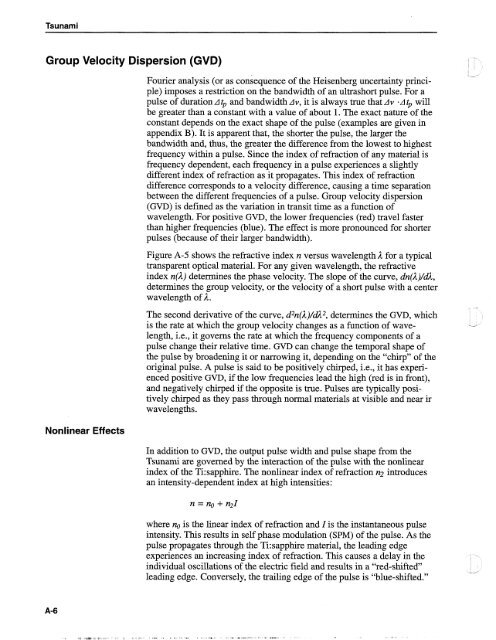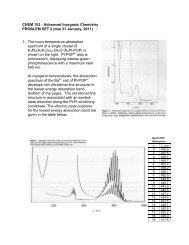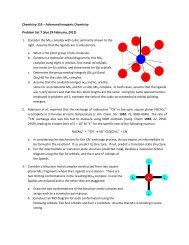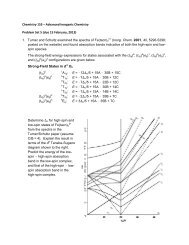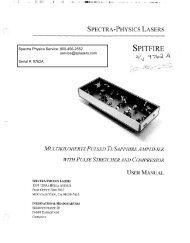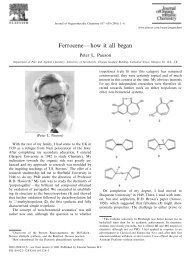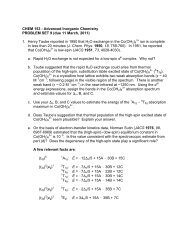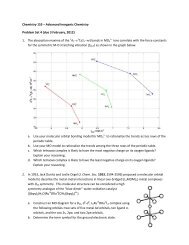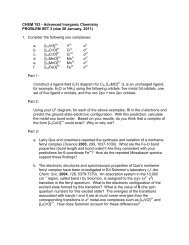Tsunami - Beckman Institute Laser Resource Center
Tsunami - Beckman Institute Laser Resource Center
Tsunami - Beckman Institute Laser Resource Center
Create successful ePaper yourself
Turn your PDF publications into a flip-book with our unique Google optimized e-Paper software.
<strong>Tsunami</strong><br />
Group Velocity Dispersion (GVD)<br />
Nonlinear Effects<br />
Fourier analysis (or as consequence of the Heisenberg uncertainty principle)<br />
imposes a restriction on the bandwidth of an ultrashort pulse. For a<br />
pulse of duration dtp and bandwidth Av, it is always true that Av -A tp will<br />
be greater than a constant with a value of about 1. The exact nature of the<br />
constant depends on the exact shape of the pulse (examples are given in<br />
appendix B). It is apparent that, the shorter the pulse, the larger the<br />
bandwidth and, thus, the greater the difference from the lowest to highest<br />
frequency within a pulse. Since the index of refraction of any material is<br />
frequency dependent, each frequency in a pulse experiences a slightly<br />
different index of refraction as it propagates. This index of refraction<br />
difference corresponds to a velocity difference, causing a time separation<br />
between the different frequencies of a pulse. Group velocity dispersion<br />
(GVD) is defined as the variation in transit time as a function of<br />
wavelength. For positive GVD, the lower frequencies (red) travel faster<br />
than higher frequencies (blue). The effect is more pronounced for shorter<br />
pulses (because of their larger bandwidth).<br />
Figure A-5 shows the refractive index n versus wavelength A for a typical<br />
transparent optical material. For any given wavelength, the refractive<br />
index n(d) determines the phase velocity. The slope of the curve, dn(A)/d;2,<br />
determines the group velocity, or the velocity of a short pulse with a center<br />
wavelength of A.<br />
The second derivative of the curve, d2n(A)/d2, determines the GVD, which<br />
is the rate at which the group velocity changes as a function of wave-<br />
.-><br />
length, i.e., it governs the rate at which the frequency components of a<br />
pulse change their relative time. GVD can change the temporal shape of<br />
the pulse by broadening it or narrowing it, depending on the "chq" of the<br />
original pulse. A pulse is said to be positively chqed, i.e., it has experienced<br />
positive GVD, if the low frequencies lead the high (red is in front),<br />
and negatively chqed if the opposite is true. Pulses are typically positively<br />
chqed as they pass through normal materials at visible and near ir<br />
wavelengths.<br />
In addition to GVD, the output pulse width and pulse shape from the<br />
<strong>Tsunami</strong> are governed by the interaction of the pulse with the nonlinear<br />
index of the Ti:sapphire. The nonlinear index of refraction n;! introduces<br />
an intensity-dependent index at high intensities:<br />
-<br />
where no is the linear index of refraction and I is the instantaneous pulse<br />
intensity. This results in self phase modulation (SPM) of the pulse. As the<br />
pulse propagates through the Ti:sapphire material, the leading edge<br />
experiences an increasing index of refraction. This causes a delay in the<br />
individual oscillations of the electric field and results in a "red-shifted"<br />
" -<br />
leading edge. Conversely, the trailing edge of the pulse is "blue-shifted."


